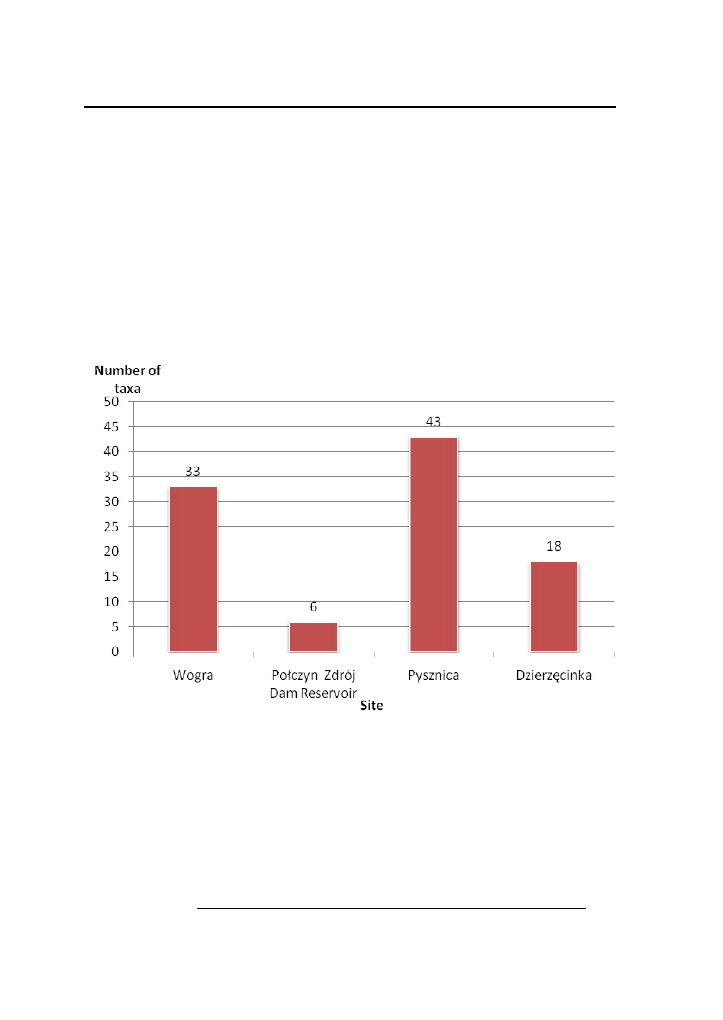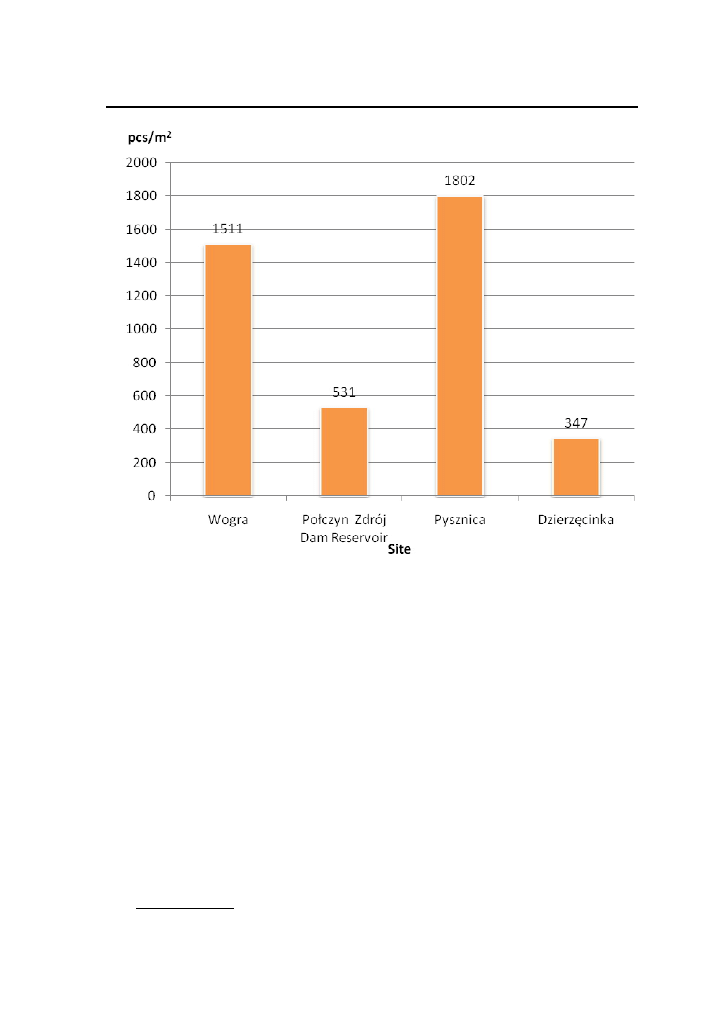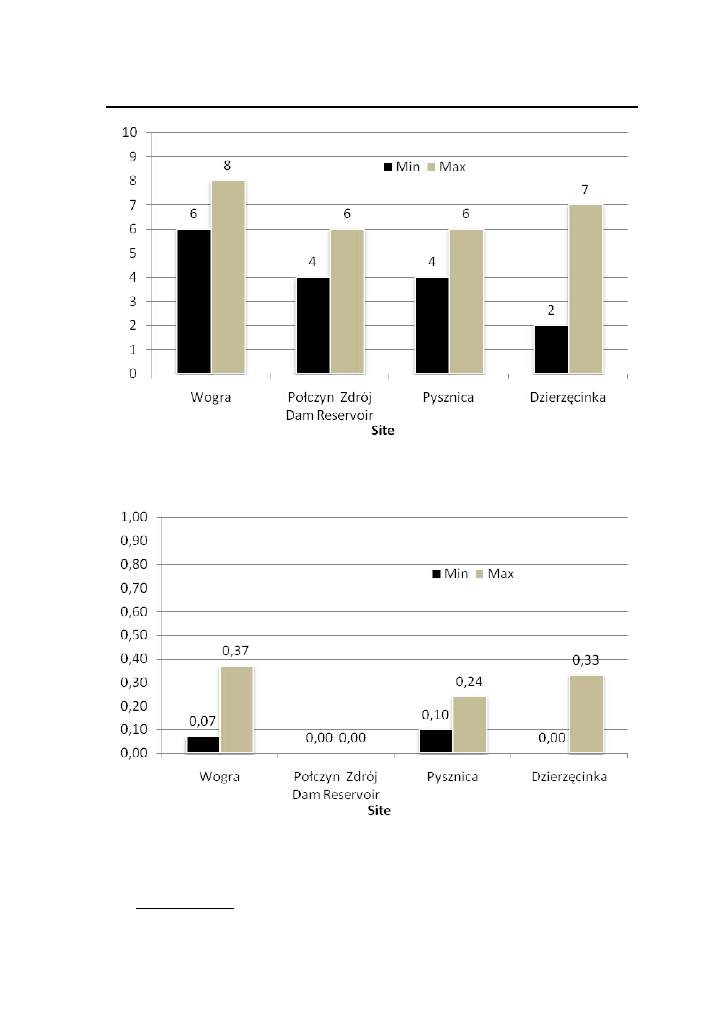
4
Assessment of Quality of Various Water Types
Based on Macrobenthic Bioindicators
Magdalena Lampart-Kałużniacka, Paweł Zdoliński,
Krzysztof Chrzanowski, Anna Górajek, Piotr Masian
Koszalin University of Technology
1. Introduction
The introduction of Water Framework Directive [5] imposed regular
conduction of water quality assessment through biomonitoring on the institu-
tions connected to aquatic environment. The Directive, at the same time has
unified the system for all member states, and required that the research be ex-
ecuted through specific biotic components, such as assemblage of species, num-
ber, population pyramid for ichthyofauna, taxonomic classification, number and
biomass of zoobenthos, phytoplankton or macrophytes. These are undoubtedly
right and beneficial resolutions, hence they allow gathering information not
only about the quality of water itself, but about the state of the entire environ-
ment [29]. This approach reveals the long-term impact of pollutants on bioindi-
cators, especially harmful impact, and bioindicator reaction to the toxic sub-
stances [10]. Benthic organisms, occurring in the environment, are responsible
for matter circulation. Making the effort of their observation, as well as gaining
insight into their physiological processes and requirements with respect to vari-
ous factors, enables determining the current state of the environment. It is also
crucial to the attempt at understanding the processes taking place in ecosystems,
and practical application of these processes in water treatment [8].
Freshwater macrozoobenthos, i.e. benthic bioindicators, are animal or-
ganisms adapted to lakebed and riverbed habitat [2]. They constitute a very
important element of those ecosystems. The organisms consume both, the ac-
cumulated matter, made by producers and the one originating from human ac-
tivity [13]. They often play the role of filter-feeders and constitute prey for fish
and birds [3].

Magdalena Lampart-Kałużniacka, Paweł Zdoliński, Krzysztof Chrzanowski, Anna Górajek, Piotr Masian
64
Środkowo-Pomorskie Towarzystwo Naukowe Ochrony Środowiska
During recent years there were often cases of, both flowing and stand-
ing, water environment degradation. The outcome of the degradation was either
partial or total elimination of macrozoobenthos. Beginning in mid 60’s of the
previous century, it was noticed that with the increase in pollution levels, Odo-
nata, Ephemeroptera and eventually Trichoptera larvae successively disappear
from the habitat [28]. Often the only remnants in the degraded habitat were
Chironomus sp. larvae and Tubificidae, which are taxons resilient to periodic
oxygen deficits. This fact was used to develop a research methodology of so
called “Biotic Indices”. Biotic Indices allowed the use of Macrozoobenthos for
measuring ecological condition of waters. In Poland the so called biomonitoring
is performed, using the mentioned organisms. The biomonitiring results are the
main aim of this paper. The following which the following areas were analyzed
with respect to the ecological condition of different types of water. The river
Wogra, together with the Połczyn-Zdrój Dam Reservoir, the river Pysznica with
its floodplains, and the river Dzierżęcinka.
2. Materials and methods
The samples were collected in 2006 and 2007 on sites at the Wogra
River, the Połczyn Zdrój Dam Reservoir, the Pysznica River and the
Dzierżęcinka River.
The river Wogra is a left-side tributary of the Dębnica River, which
falls into the Parsęta River on the 5
th
kilometer of the latter. The Wogra flows
out from Kłokowskie Lake. Its has 14.5 km in length, average fall is 6.7‰, and
watershed area is 66 km
2
.
In order to protect the city of Połczyn Zdrój as well as the Wogra River
valley from flooding, and also to regulate the river’s flow, a retention reservoir
was built on the river. The area of the reservoir is 31 km
2
, its volumetric capaci-
ty – 0.5 mln m
3
, and mean depth 2.5 m. For the reservoir to serve recreational
purposes, a dam was built on it (Fig. 1).
The Pysznica River supplises the river Parsęta on the 123
rd
kilometer.
The river’s springs are located near a village named Świemino. The river has
20 km in length, average fall of 1‰, and watershed area of 66 km
2
. Its bed is
regulated on the entire course of the river. The surrounding includes grazing
fields, grasslands and arable fields. Due to riverbed elevation and in order to
redirect its water back to its old valley, the “Pyszka Wetland” arose. The Wet-
land’s area and the land within the reservoir’s potential impact averages at 67 ha
(Fig. 1).

Assessment of Quality of Various Water Types Based on Macrobenthic…
Tom 11. Rok 2009
65
Fig 1. The comparison of research sites: A – the river Pysznica, B – the river
Dzierżęcinka, C – the river Wogra and The Połczyn Zdrój Dam Reservoir.
Rys. 1. Zestawienie stanowisk badawczych: A – rzeka Pysznica, B – rzeka
Dzierżęcinka, C – rzeka Wogra i Zbiornik zaporowy Połczyn Zdrój.
The Dzierżęcinka River located to the north-west of “Zacisze” fore-
ster’s lodge has numerous seepage springs in the Manowo forest inspectorate.
At the eighth kilometer from its spring the river flows into Lake Lubiatowskie.
The Dzierżęcinka River meets its confluence with Lake Jamno, which, in turn is
connected to the Baltic Sea by a channel. The river’s length is 26 km, its drai-
nage basin, 130 km
2
. It is the only natural water stream passing through Kosza-
lin. The Dzierżęcinka waters constitute 28% of Lake Jamno tributaries runoff.
Mean flow volume is about 0.7 m
3
/s, and the mean riverbed fall on the urban
stretch is 0.5‰ (Fig. 1).
On each site, four quantity samples and one quality sample were taken.
A hand net was used for (in compliance with [16]. The size of the openings in
the net was 0.5 mm, while the intake surface was 400 cm
2
. The samples ob-

Magdalena Lampart-Kałużniacka, Paweł Zdoliński, Krzysztof Chrzanowski, Anna Górajek, Piotr Masian
66
Środkowo-Pomorskie Towarzystwo Naukowe Ochrony Środowiska
tained were preserved with 4% formaldehyde solution and transported to the
laboratory. Before identification of the organisms, the samples were rinsed on
a benthic screen with 0.5 mm mesh diameter, by pouring through it successive
portions of the sediment diluted with water. The samples were placed under
a Nikon Eclipse E 400 stereoscope microscope. For the assessment of taxonom-
ic composition, appropriate keys and conductors were used. Straight majority of
the collected material was identified to the species level. In cases where such
precise identification was impossible, organisms were identified to the family
level. For the purpose of assessment, density and number of identified taxa were
used. Additionally, on the basis of the studies by [3, 11, 12, 15, 23] the follow-
ing biotic indices were calculated: TBI (Trent Biotic Index), BMWPPL (the
Biological Monitoring Working Party), adapted to the Polish conditions, S sa-
probe index, EPT index: ratio of the number of Ephemeroptera, Plecoptera and
Trichoptera to the number of all taxa in a sample. In calculating the above in-
dices, the methodically required level of taxonomic identification was used.
Trent Biotic Index (TBI) owes its name to the river Trent [23] and is
based on analysis of zoobenthos. Presently it is commonly used for routine
quality assessment of flowing waters. The index assumes values from 0 to 10.
The BMWP-PL index is based over a sum of points ascribed to individ-
ual taxa found in a sample. The method posits that certain taxa characterize
biocenosis better than others. The evaluation consists in assignment of point
values to 89 macrozoobenthic organism families according to their sensitivity to
pollution.
The saprobe index, according to SEW list (Sladecka), was calculated
with Pantle–Buck method [3] in accordance with the following formula:
S = Σ(h
i
∙ S
i
) / Σh
i
where:
S – saprobe index,
h
i
– abundance of the species,
S
i
– saprobe value of the species “i”.
The index used as an auxiliary water quality assessment measure was
EPT, that is the ratio of Ephemeroptera, Plecoptera and Trichoptera taxa num-
ber to the total taxa number in the tested sample, to which no ecological indexa-
tion is assigned.
The index draws upon an assumption that the first to withdraw from the
set of macrozoobenthic organisms due to the pressure of harmful conditions are
these three insecta orders. Hence, their large presence (high EPT index) points
to good water condition [3, 10].

Assessment of Quality of Various Water Types Based on Macrobenthic…
Tom 11. Rok 2009
67
Moreover, the measures used in order to better characterize separate
sites were values of biological diversity, which display the number of taxa iden-
tified at a given site, and density value, which determines the number of speci-
men corresponding to 1 m
2
of the river bottom in the area under study.
3. Results
Taking into account the diversity index (Fig. 2) it can be seen that the
most advantageous conditions for benthic fauna were presented in the Pysznica
river, where as many as 43 macrozoobenthic taxa were identified. The least
favorable conditions, on the other hand, were observed in the Połczyn Zdrój
Dam reservoir, where only 6 taxa of the organisms in question were recorded.
Fig. 2. The diversity in macrozoobenthos at research sites
Rys. 2. Zróżnicowanie makrozoobentosu na stanowiskach badawczych
The maximum density (Fig. 3) of benthic organisms In this paper was
noted for the Pysznica river (1802 pcs per m
2
), in contrast, the lowest numbers
of macrozoobenthos per one square meter were detected in the Dzierżęcinka
river.

Magdalena Lampart-Kałużniacka, Paweł Zdoliński, Krzysztof Chrzanowski, Anna Górajek, Piotr Masian
68
Środkowo-Pomorskie Towarzystwo Naukowe Ochrony Środowiska
Fig. 3. Macrozoobenthos density at research sites
Rys. 3. Zagęszczenie makrozoobentosu na stanowiskach badawczych
Both, the Saprobe (Fig. 4) and BMWP-PL (Fig. 5) indices reached the
optimal values, as did diversity (Fig. 1), for the Pysznica river (1.33 and 115
respectively). Less satisfying, however, were results recorded for the Połczyn
Zdrój Dam reservoir (3.80 and 5).
According to the results gathered for TBI (Fig. 6) and EPT index
(Fig. 7) the Wogra river possessed the most favorable conditions for the devel-
opment of benthic fauna. The Dzierżęcinka river, in its turn, was characterized
by the least favorable habitat conditions for benthic organisms. At the same
time, zero EPT values were recorded twice in the case of the Połczyn Zdrój
Dam Reservoir (Fig. 7).

Assessment of Quality of Various Water Types Based on Macrobenthic…
Tom 11. Rok 2009
69
Fig. 4. Saprobe index comparison on research sites
Rys. 4. Zestawienie wskaźnika saprobowego na stanowiskach badawczych
Fig. 5. BMWP-PL index comparison on research sites
Rys. 5. Zestawienie wskaźnika BMWP-PL na stanowiskach badawczych

Magdalena Lampart-Kałużniacka, Paweł Zdoliński, Krzysztof Chrzanowski, Anna Górajek, Piotr Masian
70
Środkowo-Pomorskie Towarzystwo Naukowe Ochrony Środowiska
Fig. 6. TBI Index comparison on research sites
Rys. 6. Zestawienie wskaźnika TBI na stanowiskach badawczych
Fig. 7. EPT index comparison on research sites
Rys. 7. Zestawienie wskaźnika EPT na stanowiskach badawczych

Assessment of Quality of Various Water Types Based on Macrobenthic…
Tom 11. Rok 2009
71
4. Discussion
Biological methods record long-term changes in a given aquatic ecosys-
tem, which is an undeniable advantage [6]. These changes are difficult to dem-
onstrate while analysing physicochemical parameters as they characterize water
quality only at the time of sample collection [28]. First biotic indices came into
being already in the second half of the 19th century [9, 14, 25], the decline of
many species of aquatic organisms as a result of adverse changes in water quali-
ty caused mainly by developing industry had its contribution to this process.
Since the 60’s of the 20
th
century, the indices became commonly used for water
quality assessment. [1, 4, 14, 26].
Macroinvertebrates constitute a group of organisms most frequently
used in biomonitoring studies of rivers [18]. One of the possible and most popu-
lar approaches is the use of taxonomic lists to calculate a “biotic index” which
summarizes in a single number the information provided by the population
structure [21]. Two types of such indices can be distinguished. Diversity indices
are related to the population structure and are not specific to any type of conta-
mination; in contrast biotic indices, are based on the tolerance of taxa to a par-
ticular pollutant [7].
Diversity (Fig. 2) and density (Fig. 3) indices proved that the highest
water quality was found in the Pysznica river. This is a watercourse formerly
put through the process of renaturalization, the aim of which was to recreate
natural, existent before transformation, floodplains. River regulation and dam-
ming are considered to have the most important destructive impact on biota due
to terrestrialisation and fragmentation of the river floodplain system [20]. The
difference between natural and regulated river consists in the fact that the for-
mer is characterized by abundance of river structures, whereas the latter by their
lack or poverty, which in turn has a vast impact on living and dwelling condi-
tions of river organisms, including invertebrates [22]. The received diversity
(Fig. 2) and density (Fig. 3) results confirmed that habitats formed in renatura-
lized watercourse were the most advantageous for benthos. Poor results for the
Połczyn Zdrój Dam reservoir, created as a result of antropogenic regulations
also indicate essential aspect of natural river continuum. Such situation may be
as well explained by the young age of the reservoir which – as it results from
the recent research conducted by the department of Environmental Biology at
the Koszalin University of Technology – has not been inhabited yet by the typi-
cal hololimnic fauna. At the same time, scarce macrozoobenthos may be a result
of adverse physiochemical conditions prevailing in these waters as for example
lack of oxygen in the vicinity of the bottom, despite the very small depth of the
reservoir. Such conditions cause the occurrence of specific group of organisms
which can adapt themselves to those very hard conditions. Ephemeroptera, Ple-

Magdalena Lampart-Kałużniacka, Paweł Zdoliński, Krzysztof Chrzanowski, Anna Górajek, Piotr Masian
72
Środkowo-Pomorskie Towarzystwo Naukowe Ochrony Środowiska
coptera and Trichoptera families cannot be includes there, as they require more
advantageous habitat conditions. It may be confirmed by the EPT index, which
reached zero values for the reservoir (Fig. 7).
Also other biotic indices: S (Fig. 4), BMWP-PL (Fig. 5) support the
above results concerning the dam reservoir. BMWP-PL index in literature is
often judged to be the best for surface water assessment. According to [7, 27]
only this index is seasonally independent and therefore it is adequate for water
quality verification at different seasons of the year. The best value of this index
occurred in the Pysznica river (Fig. 4) which may be confirmed by the positive
aspects of conducted renaturalization process.
Comparing gathered results concerning the Dzierżęcinka river with re-
sults of [13] it can be observed that diversity and density reached lesser values
than in 2006. Biotic indices did not reveal any significant differences. The drop
in taxa quantity is significant (10 taxa), however an increase in EPT index took
place. It may indicate decrease in the number of various habitats, as a type of
substratum is the main factor influencing settlement of macroinvertebrates
[17,19,24]. As a result of homogenization of the environment domination of
conditions favored by organisms particularly vulnerable to pollutants (Epheme-
roptera, Plecoptera and Trichoptera) took place.
The use of the biota in freshwater quality assessment is a requirement
under the European Union’s Water Framework Directive. The results gathered,
show that biological indices, especially BMWP, adapted to Polish conditions,
have sufficient sensitivity to assess the state of natural environment of various
types of surface waters. However, methods based on these studies which are
used in water quality assessment require further verification and testing on dif-
ferent river types [28].
References
1.
Admiraal W., van der Velde G., Smit H., Cazemier G.: The Rivers Rhine and
Meuse in The Netherlands: present state and signs of ecological recovery. Hydro-
biologia, 265: 97-128, 1993.
2.
Allan J. D.: Ecology of flowing waters. Wydawnictwo Naukowe PWN, Warsaw:
450, 1998.
3.
Błachuta J., Żurawska J., Brzostek-Nowakowska J., Martynko-Pluta E., Mi-
luch J., Kassyk W., Wierzchowska E., Berendt I., Zakościelna A.: Monitoring
of surface waters in Zachodniopomorskie Province. Macroinvertebrates: 62, 2002.
4.
Cals M.J.R., Postma R., Marteijn E.C.L.: Ecological river restoration in The
Netherlands: state of the art and strategies for the future. Aquatic Consevation:
Marine and Freshwater Ecosystems, 8: 61-70, 1996.

Assessment of Quality of Various Water Types Based on Macrobenthic…
Tom 11. Rok 2009
73
5.
Council of the European Communities: Directive 2000/60/EC, Establishing a
Framework for Community Action in the Field of Water Policy. European Com-
mission PE-CONS 3639/1/100 Rev 1, Luxembourg, 2000.
6.
Fleituch T., Soszka H., Kudelska D., Kownacki A.: The use of macroinverte-
brates as indicators of water quality in rivers: a scientific basis for Polish stan-
dard method. Large Rivers vol. 13, Arch. Hydrobiol. Suppl. 141/3 no 3-4: 225-
239, 2002.
7.
Garcia-Criado F., Tomé A., Vega F.J., Antolin C.: Performance of some diver-
sity and biotic indices in rivers affected by coal mining in northwestern Spain. Hy-
drobiologia, Kluwer Academic Publishers, Leon, 394: 209-217, 1999.
8.
Hartmann L.: Biologiczne oczyszczanie ścieków. Wydawnictwo Instalator Polski,
Warsaw, 1999.
9.
Klink A.: The Lower Rhine: paleoecological analysis. [in] “Historical Change of
Large Alluvial Rivers: Western Europe”. John Willey, Chichester: 183-201, 1989.
10. Kołodziejczyk A., Koperski P., Kamiński M.: Klucz do oznaczania słodkowod-
nej makrofauny bezkręgowej dla potrzeb bioindykacji stanu środowiska”. Biblio-
teka Monitoringu Środowiska, Państwowa Inspekcja Ochrony Środowiska, War-
saw: 136, 1998.
11. Kownacki A., Soszka H., Kudelska D., Flejtuch T.: Bioassessment of Polish
rivers based on macroinvertebrates. [in] “11th Magdeburg seminar on Waters In
Central and Eastern Europe: Assessment, Protection, Management” Geller W. et
al. (eds.). Proceedings of the international conference, 18-22 October 2004 at the
UFZ. UFZ-Bericht, 18/2004: 250-251, 2004.
12. Kownacki A., Soszka H.: Guidelines for the evaluation of the status of rivers on
the basis of macroinvertebrates and for intakes of macro-invertebrate samples in
lakes. Warsaw: 51, 2004.
13. Lampart-Kałużniacka M., Celińska-Spodar A.: Monitoring miejskiego odcinka
Dzierżęcinki z wykorzystaniem makrobentosu w celu renaturyzacji koryta rzeki.
Rocznik Ochrona Środowiska 10/2008: 444-457, 2008.
14. Lelek A.: The Rhine River and some on its tributaries under human impact in the last
two centuries. [in] “Proc. Intern. Large River Symposium” Dodge D.P. (ed.). Canadian
Special Publication of Fisheries and Aquatic Sciences, 106: 469-487, 1989.
15. Pantle E., Buck H.: Die biologische Überwachung der Gewasser und die Darstel-
lung der Ergebnisse. Gas und Wasserfach, 96: 604, 1955.
16. PN-EN 27828. Methods to take samples for biological examinations: guidelines
for macrobenthos intake with the use of a hand net. Polish Normalization Commit-
tee: 10, 2001.
17. Richards C., Host G.E., Arthur J.W.: Identification of predominant environmen-
tal factors structuring stream macroinvertebrate communities within a large agri-
cultural catchment. Freshwat. Biol., 29: 285-294, 1993.
18. Rosenberg D.M., Resh V.H.: Introduction to freshwater biomonitoring and ben-
thic macroinvertebrates. [in] “Freshwater Biomonitoring and Benthic Macroinver-
tebrates”. Chapman and Hall, New York: 1-9, 1993.

Magdalena Lampart-Kałużniacka, Paweł Zdoliński, Krzysztof Chrzanowski, Anna Górajek, Piotr Masian
74
Środkowo-Pomorskie Towarzystwo Naukowe Ochrony Środowiska
19. Ruse L.P.: Multivariate techniques relating macroinvertebrate and environmental
data from a river catchment. Wat. Res., 30: 3017-3024, 1996.
20. Schiemer F.: Conservation of biodiversity in floodplain rivers. Archiv. für Hydro-
biologie, Supplement, 115: 423-438, 1999.
21. Solimini A.G., Gulia P., Monfrinotti M., Carchini G.: Performance of different
biotic indices and sampling methods in assessing water quality in the lowland
stretch of the Tiber River. Hydrobiologia, Kluwer Academic Publishers, Roma,
422/423: 197-208, 2000.
22. Ślizowski R., Radecki-Pawlik A., Huta K.: Analiza wybranych parametrów
hydrodynamicznych na bystrzu o zwiększonej szorstkości na Potoku Sanoczek. In-
frastructure and Ecology of Rural Areas, Polska Akademia Nauk, Cracow, 2: 47-
58, 2008.
23. Woodiwiss F.S.: The biological system of stream classification used by the Trent
River Board. Chemistry and Industry, 11, 443-447, 1964.
24. Wright J.F., Moss D., Armitage P.D., Furse M.T.: A preliminary classification
of running-water sites in Great Britain based on macro-invertebrate species and
the prediction of community type using environmental data. Freshwat. Biol., 14:
221-256, 1984.
25. Van der Brink F.W.B., van der Velde G., Cazemier W.G.: The faunistic com-
position of the freshwater section of the River Rhine in The Netherlands: present
state and changes since 1990. [in] “Biologie des Rheins” Kinzelbach R., Friedrich
G. (eds). Vol. 1, Limnologie Aktuell: 191-216, 1990.
26. Van Urk G., Bij de Vaate: Ecological studies in the Lower Rhine in The Nether-
lands. [in] “Biologie des Rheins” Kinzelbach R., Friedrich G. (eds). Vol. 1, Lim-
nologie Aktuell: 131-145, 1990.
27. Zamora-Muñoz C., Sáinz-Cantero C.E., Sánchez-Ortega A., Alba-Tercedor
J.: Are biological indices BMWP and ASPT and their significance regarding wa-
ter quality seasonally dependent? Factors explaining their variations. Wat. Res.,
29: 285-290, 1995.
28. Zdoliński P., Lampart-Kałużniacka M.: Biological monitoring of the surface
Pomeranian rivers (North Poland) on the basis of the macroinvertebrates. Ocea-
nological and Hydrobiological Studies, Vol. 36, Supplement 4: 119-126, 2007.
29. Żmudziński L., Kornijów R., Bolałek J., Górniak A., Olańczuk-Neymann K.,
Pęczalska A., Korzeniewski K.: Słownik Hydrobiologiczny (ochrona wód, termi-
ny, pojęcia i interpretacje). Wydawnictwo Naukowe PWN, 2002.

Assessment of Quality of Various Water Types Based on Macrobenthic…
Tom 11. Rok 2009
75
Ocena stanu jakości różnych typów wód na podstawie
makrobentosowych wskaźników biotycznych
Streszczenie
Niniejsze badania prowadzono w 2006 i 2007 roku. Objęto nimi: rzeki: Pyszni-
cę, Dzierżęcinkę oraz Wogrę, wraz ze zbiornikiem zaporowy w Połczynie Zdroju.
Każdorazowo pobrano cztery próby ilościowe i jedną próbę jakościową, za
pomocą siatki ręcznej, co zgodne jest z normą PN-EN 27828:2001. Do oszacowania
składu taksonomicznego wykorzystano stosowne klucze i przewodniki.
Na podstawie zaklasyfikowanych organizmów obliczono ich zróżnicowanie
i zagęszczenie oraz indeksy biotyczne: TBI (ang. Trent Biotic Index), BMWP-PL (ang.
Biological Monitoring Working Party), przystosowany do warunków polskich, wskaź-
nik saprobowy S, wskaźnik EPT – stosunek liczby taksonów jętek (Ephemeroptera),
widelnic (Plecoptera) i chruścików (Trichoptera) do liczby wszystkich taksonów
w próbie. Na tej podstawie wnioskowano o stanie ekologicznym badanych wód.
Najkorzystniejszy stan ekologiczny stwierdzono na rzece Pysznicy, która od-
prowadza wody ze zrenaturyzowanego terenu “Mokradło Pyszka”. Jest to obszar odda-
ny do eksploatacji w 2004 roku. na którym m.in. usypano wyspy z gruntów organicz-
nych. Spowodowało to zmianę morfologii koryta, co zaskutkowało wzrostem obfitości
nowych mikrosiedlisk i pojawieniem się większej przestrzeni życiowej dla organizmów
wodnych. Opisane zabiegi techniczne wpłynęły korzystnie na bioróżnorodność popula-
cji, co spowodowało poprawę stanu ekologicznego wód.
W analizowanych badania najmniej korzystne wartości indeksów odnotowano
w przypadku zbiornika zaporowego w Połczynie Zdroju. Fakt ten można tłumaczyć,
młodym jego wiekiem, dlatego nie zdążyły się tutaj wytworzyć jeszcze typowe dla
jezior, siedliska bytowania makrofauny, co niekorzystnie wpłynęło na stan wód.
Wyniki przeprowadzonych badań wykazały, że metody biologiczne oparte na
makrobezkręgowcach (popularne i szeroko stosowane w wielu krajach Europy Zachod-
niej i nie tylko) charakteryzują się wystarczającą czułością i są wspólnie z badaniami
fizyczno-chemicznymi oraz morfologicznymi, odpowiednie do oceny stanu ekologicz-
nego wód.

Wyszukiwarka
Podobne podstrony:
DIN 61400 21 (2002) [Wind turbine generator systems] [Part 21 Measurement and assessment of power qu
Assessment of cytotoxicity exerted by leaf extracts
Guidance on human health risk benefit assessment of foods
03 Electrophysiology of myocardium Myocardial Mechanics Assessment of cardiac function PL
23 List of hobbies
Assessment of thyroid, testes, kidney and autonomic nervous system function in lead exposed workers
ONeil Status of Hollands Personality Types
Assessment of proliferative activity of thyroid Hürthle
Assessment of cytotoxicity exerted by leaf extracts
a lot of various circuits index 9028613 25 4790
a lot of various circuits index 2628613 25 4526
Assessment of Borderline Pathology Using the Inventory of Interpersonal Problems Circumplex Scales (
a lot of various circuits index 7528613 25 4775
a lot of various circuits index 8228613 25 4782
a lot of various circuits index 8528613 25 4785
a lot of various circuits index 27628613 25 52276
a lot of various circuits index 25328613 25 51253
a lot of various circuits index 16028613 25 49160
a lot of various circuits index 19228613 25 50192
więcej podobnych podstron